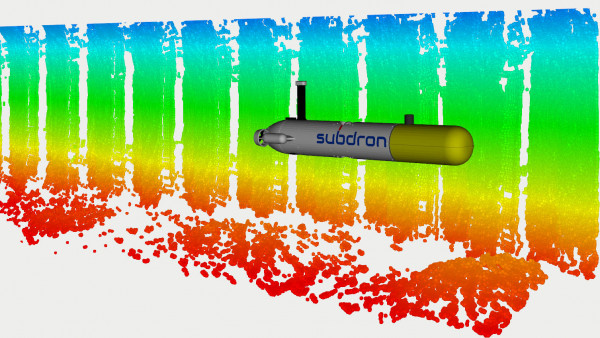Interviews
Subdron is redefining underwater inspections with AI and robotics—making maritime operations safer, greener, and more efficient.
July 31, 2025
·
5
min read
%20-%20%20Subdron%20interview.png)
As global shipping and port operations face rising pressure to reduce emissions, improve efficiency, and cut costs, the need for smarter, scalable underwater inspection technology is more urgent than ever. While only 0.9% of vessels entering EU ports are inspected for security threats such as illegal cargo or unauthorized modifications, this leaves major vulnerabilities in maritime operations. Separately, the economic impact of biofouling alone is enormous, costing the U.S. maritime industry an estimated $36 billion annually through increased fuel consumption, emissions, and maintenance needs.
Subdron is tackling these challenges with the first fully autonomous underwater inspection platform, combining robotics, AI, and real-time data visualization to help shipowners, ports, and maritime authorities inspect faster, safer, repeatable, and more cost-effectively.
We sat down with Thomas Vonach, CEO of Subdron, to talk about the beginning of the company, the tech behind the platform, and how autonomous underwater inspections can reshape both commercial and defense maritime operations.
I grew up near Lake Constance and have always been deeply connected to water. My passion for technology and innovation combined with this affinity for water inspired me to rethink how underwater inspections are conducted. I saw the inefficiencies, risks, and high costs of traditional methods and wanted to create a smarter, safer, and more efficient solution. With Subdron, I’m also contributing to environmental protection by reducing emissions and tackling the challenges caused by biofouling.

Traditional diver-based inspections are always associated with safety risks, while ROVs require manual piloting, support vessels, and skilled operators. With our autonomous solution, we eliminate these challenges, significantly increasing safety and minimizing downtime. The system can inspect up to 2 km per day and delivers high-resolution scans with 5 cm precision, even in zero-visibility conditions. Another key advantage is that we can repeatedly locate and inspect the exact same point over time, enabling precise comparisons, predictive maintenance and long-term monitoring. This makes our solution both more efficient and more reliable than traditional methods.
Our system is deployed directly at the port or vessel location, scanning ship hulls or harbor walls along unknown routes without requiring a pilot. We collect high-resolution data and process it to create a 3D digital twin of the structure. Currently, it takes around 2-3 days to deliver a complete report, but with our upcoming AI-driven analysis, this will be reduced to just a few hours. This enables customers to plan maintenance efficiently and minimize downtime.
Every millimeter of growth on a ship’s hull means more drag, more fuel, and more emissions. Studies show that a 2.5 mm layer of biofilm and barnacles can increase fuel use by over 30%, adding billions in costs and CO₂ emissions globally. Our inspections allow shipowners to detect fouling early, plan efficient maintenance, and avoid unnecessary emissions. For ports and critical subsea infrastructure, our detailed digital twins help extend the lifespan of assets by detecting corrosion, cracks, and structural weaknesses before they become major problems. This reduces the need for costly replacements and supports more sustainable asset management.
Port authorities highlight the precision and efficiency of our inspections, which allow them to shift from reactive to proactive maintenance planning. They particularly appreciate the improved safety for their teams, as no divers need to enter potentially hazardous environments. Another point of positive feedback is the scalability of our solution and the value of the data-driven insights we provide, which support smarter long-term asset management.
Our technology is highly relevant for naval and defense applications because it can autonomously inspect critical subsea infrastructure (e.g. subsea cables and pipelines) and vessel hulls without exposing personnel to risk. For example, our system can help detect anomalies such as mines or other suspicious objects attached to ship hulls or harbor walls. By providing high-resolution, repeatable scans, we enable navies and port security teams to monitor and secure underwater assets more effectively, ensuring both safety and operational readiness.
Our strategy focuses on close collaboration with port authorities, shipowners, and infrastructure operators. We are expanding through strategic partnerships and pilot projects in key maritime hubs across Europe and beyond. In addition, we follow a Robotics-as-a-Service model, enabling our customers to benefit from cutting-edge technology, advanced data analytics, and reporting without the need to operate their own hardware.
Technically, achieving reliable autonomous navigation and real-time 3D digital twin creation has been a major breakthrough. Commercially, our first successful customer projects – including Baltic Cable and the Port of Kehl – have proven the viability of our solution. Building on this foundation, we are now actively pursuing large-scale opportunities with major port authorities. Raising € 5.9 million in funding and opening our branches in Porto (Portugal) and Rostock (Germany) are additional milestones that support our scaling strategy.
The current funding round will allow us to accelerate R&D, expand our fleet of autonomous drones, and further strengthen our AI-driven analytics platform. We are also focusing on entering additional key maritime markets across Europe and beyond. The maritime industry is at a turning point: stricter regulations on biofouling and emissions, combined with rising operational costs, are increasing the demand for scalable and data-driven inspection solutions. Subdron’s fully autonomous system is designed to meet these needs – offering faster, safer, and more cost-effective inspections. Now is the perfect time for investors to join us in shaping the future of underwater infrastructure management.